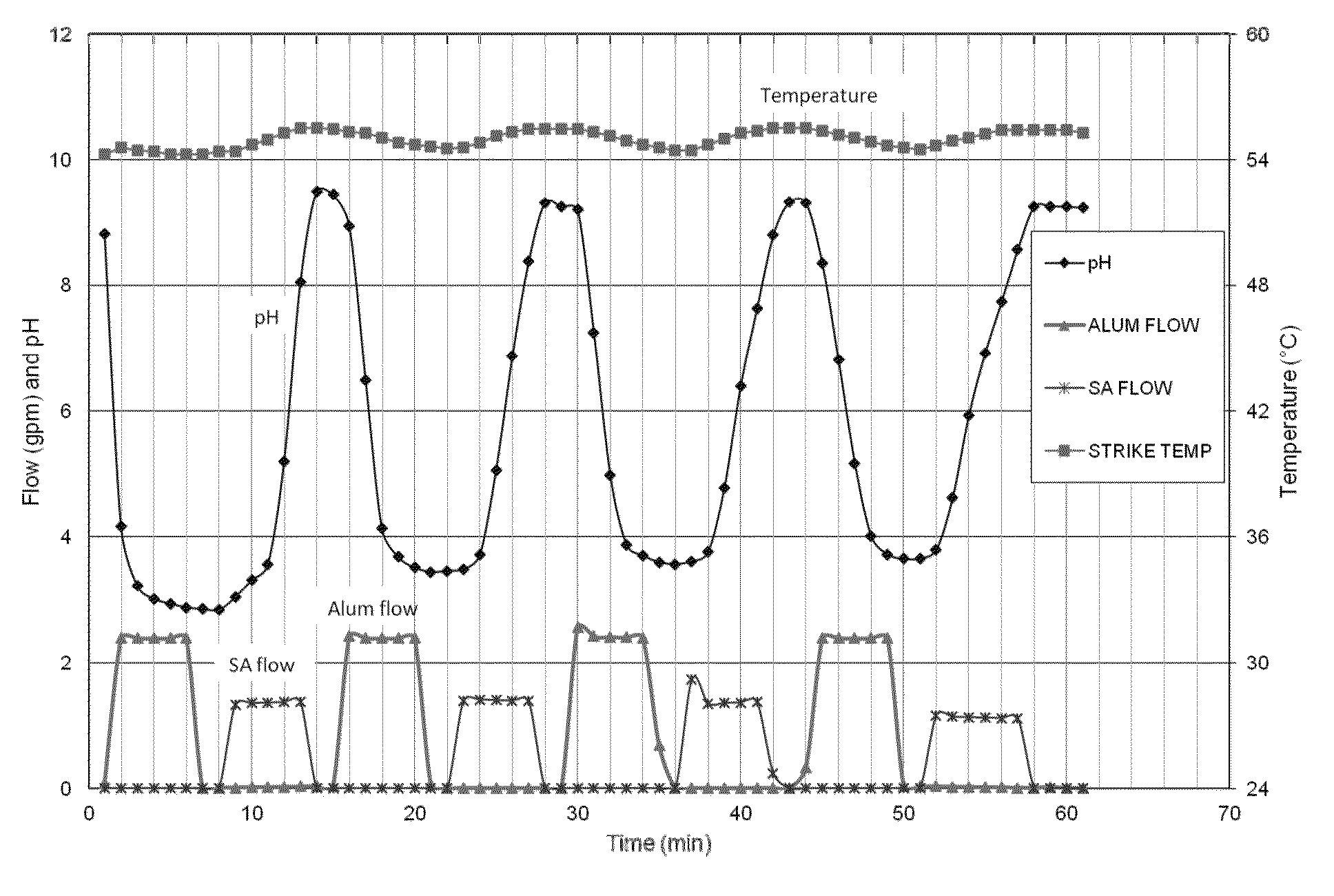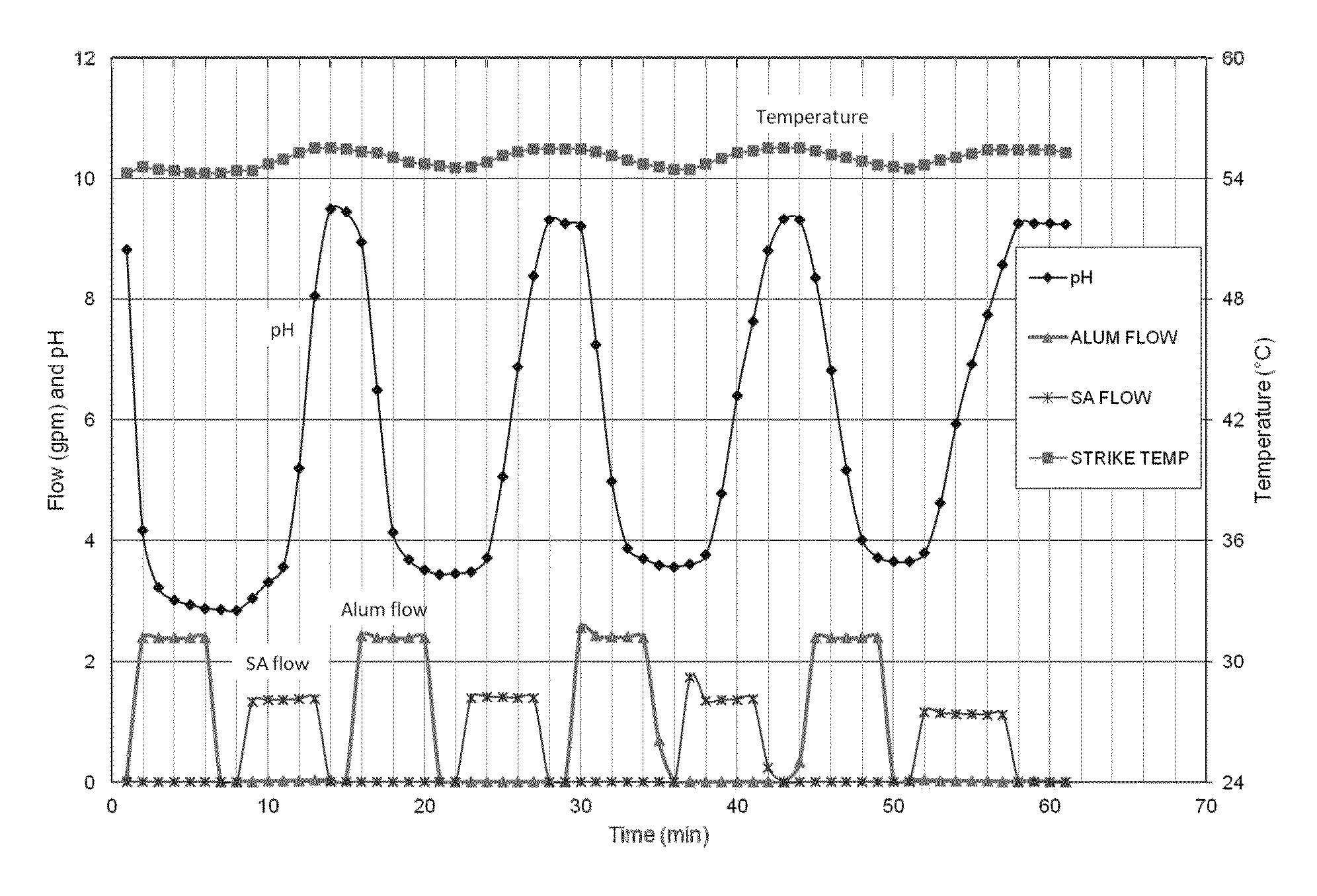Resid hydrotreating catalyst
a hydrotreating catalyst and resin technology, applied in the direction of catalyst activation/preparation, physical/chemical process catalysts, metal/metal-oxide/metal-hydroxide catalysts, etc., can solve the problems of reducing their effectiveness, and achieve the effect of increasing catalytic activity and stability
- Summary
- Abstract
- Description
- Claims
- Application Information
AI Technical Summary
Benefits of technology
Problems solved by technology
Method used
Image
Examples
example 1
[0066]Water was added to a vessel which was heated to temperature of 54.2° C. Into the water was added an aqueous stream of aluminum sulfate (7 wt % a Al2O3) while stirring until the pH reached 2.85. An aqueous stream of sodium aluminate (23.5 wt % Al2O3) was then added until the pH reached 9.49. The addition of sodium aluminate was stopped and the mixture was aged for about 3 minutes to complete one swing cycle. The addition rate of the aluminum sulfate and the sodium aluminate solutions were continued respectively so as to cycle two more times the pH of the solution between 3.4 and 9.3, and 3.5 and 9.3, respectively, while maintaining a temperature of about 55° C. as depicted in FIGURE.
[0067]At the end of the third cycle, aqueous aluminum sulfate was added to decrease the pH to 3.6. Then aqueous sodium aluminate was added to increase the pH to about 9.2. The precipitated alumina mix was then filtered to provide a filter cake. The filter cake was water washed on a belt filter to re...
example 2
[0075]The performance of Catalyst A and Catalyst B prepared in Example 1 and Comparative Example 1, respectively, were evaluated as follows: The catalyst pellets were loaded in a plug-flow reactor. The feed consisted of an atmospheric resid and hydrogen. The resid had a metal content of 362 ppm V and 71 ppm Ni and a Sulfur content of 4.6 wt %. The reactor temperature was maintained at 713° F., and the average hourly space velocity was 0.75 L / (L.h). Comparative results for metal and sulfur conversion are given in the table below. The results are given for liquid product samples collected at three different time-on-stream values (209, 401, and 617 hours).
[0076]
TABLEVanadiumNickelSulfurMCRconversion, %conversion, %conversion, %conversion, %atatatatatatatatatatatat209 h401 h617 h209 h401 h617 h209 h401 h617 h209 h401 h617 hCatalyst A68.767.465.751.051.350.640.841.243.126.426.829.3Catalyst B65.564.263.545.545.649.035.833.536.222.723.923.6
[0077]As can be seen in the table above, Catalyst ...
PUM
| Property | Measurement | Unit |
|---|---|---|
| temperature | aaaaa | aaaaa |
| temperature | aaaaa | aaaaa |
| temperature | aaaaa | aaaaa |
Abstract
Description
Claims
Application Information
 Login to View More
Login to View More - R&D
- Intellectual Property
- Life Sciences
- Materials
- Tech Scout
- Unparalleled Data Quality
- Higher Quality Content
- 60% Fewer Hallucinations
Browse by: Latest US Patents, China's latest patents, Technical Efficacy Thesaurus, Application Domain, Technology Topic, Popular Technical Reports.
© 2025 PatSnap. All rights reserved.Legal|Privacy policy|Modern Slavery Act Transparency Statement|Sitemap|About US| Contact US: help@patsnap.com


